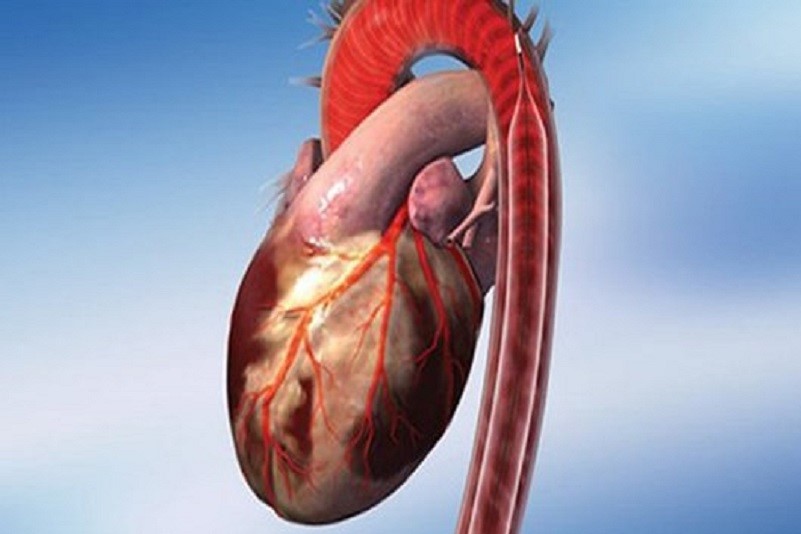
Aortic valvulopathy: what is it?
With ” Aortic valvulopathy ” we mean a condition in which the aortic valve – the structure that regulates the one-way flow of blood from the left ventricle of the heart to the aorta – is no longer able to perform its function
This happens when the valve – made up of three flaps of tissue – becomes clogged or can no longer close perfectly.
In the first case, we will be dealing with aortic stenosis.
In the second case, however, we will find ourselves dealing with aortic insufficiency.
In both cases, the left ventricle hypertrophies and deforms due to the effort, presenting in the long run significant dysfunctions in the contraction of the heart muscle, which can subsequently result in heart failure.
Aortic valve disease: the causes
Aortic valve disease has different causes based on the defect found in the valve. If we are in the presence of aortic stenosis, this can be congenital or acquired.
When congenital, the condition most frequently found in children is bicuspid: the aortic valve is not formed by three flaps but by two.
When acquired, calcific aortic stenosis occurs in late adulthood in conjunction with other risk factors such as arteriosclerosis, hypertension and hypercholesterolemia; it is consequently destined to increase with increasing age.
On the other hand, when we are in the presence of aortic insufficiency, the causes could be found in some infectious diseases such as endocarditis, hypertension, autoimmune diseases, the intake of some slimming drugs or – much more frequently – aortic insufficiency can be degenerative.
Much rarer is aortic insufficiency of congenital origin.
Aortic valvulopathy: symptoms
If it presents itself in the form of aortic stenosis, aortic valve disease can remain asymptomatic for a long time and can only be detected during a clinical visit thanks to the presence of the typical systolic murmur in the aortic auscultation region.
If symptomatic, the most common symptoms are chest pain, difficulty breathing, and syncope, often co-occurring.
Even aortic insufficiency can remain asymptomatic for a long time but, if it is not, the most frequent symptoms are fatigue, chest pain, shortness of breath, dizziness, perception of irregular heartbeat or unjustifiably accelerated.
In the most serious cases – both in the presence of aortic stenosis and aortic insufficiency – cardiovascular collapses can occur which lead, in the most serious case, to the death of the patient.
Aortic valve disease: diagnosis and treatment
Each of the symptoms listed above must in no way be underestimated: each of these could be an alarm bell that leads the patient to promptly request a prescription for a specialist cardiological visit from his general practitioner.
During the latter, after having carried out an accurate anamnesis, some in-depth tests will be prescribed to carefully evaluate the patient’s cardiac situation such as transthoracic and/or transesophageal EcocolorDoppler.
Once aortic valve disease has been diagnosed, the cardiologist specialist could prescribe drug therapy to the patient, which will only serve to alleviate the disturbances deriving from the pathological condition; otherwise it will be possible to consider – as a definitive solution – surgery for the insertion of a valve prosthesis, mechanical or in biological tissue.
Alternatively, there are some minimally invasive percutaneous techniques for replacing the defective aortic valve, currently feasible only in the case of aortic stenosis.
Aortic valvulopathy: risk factors and prevention
When it is not of congenital origin, aortic valve disease generally occurs in elderly subjects who therefore present with rheumatic or degenerative forms, characterized by inflammatory phenomena and aggravated by the usual cardiovascular risk factors such as smoking, diabetes, hypertension, hypercholesterolemia.
Consequently, prevention intervenes from the moment in which the main risk factors are limited, leading a healthy, physically active life characterized by a diet low in calcium and saturated fats.
Read Also
Emergency Live Even More…Live: Download The New Free App Of Your Newspaper For IOS And Android
Heart Murmur, An Often Innocent Rustling Sound: What It Is
Heart Murmur: What Is It And What Are The Symptoms?
Altered Heart Rate: Palpitations
Knowing Thrombosis To Intervene On The Blood Clot
Heart: What Is A Heart Attack And How Do We Intervene?
Do You Have Heart Palpitations? Here Is What They Are And What They Indicate
Palpitations: What Causes Them And What To Do
Heart Diseases And Alarm Bells: Angina Pectoris
Fakes That Are Close To Our Hearts: Heart Disease And False Myths
Sleep Apnoea And Cardiovascular Disease: Correlation Between Sleep And Heart
Myocardiopathy: What Is It And How To Treat It?
Venous Thrombosis: From Symptoms To New Drugs
Cyanogenic Congenital Heart Disease: Transposition Of The Great Arteries
Heart Rate: What Is Bradycardia?
Consequences Of Chest Trauma: Focus On Cardiac Contusion
Aortic Insufficiency: Causes, Symptoms, Diagnosis And Treatment Of Aortic Regurgitation
Congenital Heart Disease: What Is Aortic Bicuspidia?
Atrial Fibrillation: Definition, Causes, Symptoms, Diagnosis And Treatment
Ventricular Fibrillation Is One Of The Most Serious Cardiac Arrhythmias: Let’s Find Out About It
Atrial Flutter: Definition, Causes, Symptoms, Diagnosis And Treatment
What Is Echocolordoppler Of The Supra-Aortic Trunks (Carotids)?
What Is The Loop Recorder? Discovering Home Telemetry
Cardiac Holter, The Characteristics Of The 24-Hour Electrocardiogram
Peripheral Arteriopathy: Symptoms And Diagnosis
Endocavitary Electrophysiological Study: What Does This Examination Consist Of?
Cardiac Catheterisation, What Is This Examination?
Echo Doppler: What It Is And What It Is For
Transesophageal Echocardiogram: What Does It Consist Of?
Paediatric Echocardiogram: Definition And Use
Electrical Cardioversion: What It Is, When It Saves A Life
Heart Murmur: What Is It And What Are The Symptoms?
Performing The Cardiovascular Objective Examination: The Guide
Branch Block: The Causes And Consequences To Take Into Account
Cardiopulmonary Resuscitation Manoeuvres: Management Of The LUCAS Chest Compressor
Supraventricular Tachycardia: Definition, Diagnosis, Treatment, And Prognosis
Identifying Tachycardias: What It Is, What It Causes And How To Intervene On A Tachycardia
Myocardial Infarction: Causes, Symptoms, Diagnosis And Treatment
Semeiotics Of The Heart: History In The Complete Cardiac Physical Examination
Heart Murmur: What Is It, What Causes It And Most Importantly… Do We Need A Cure?


